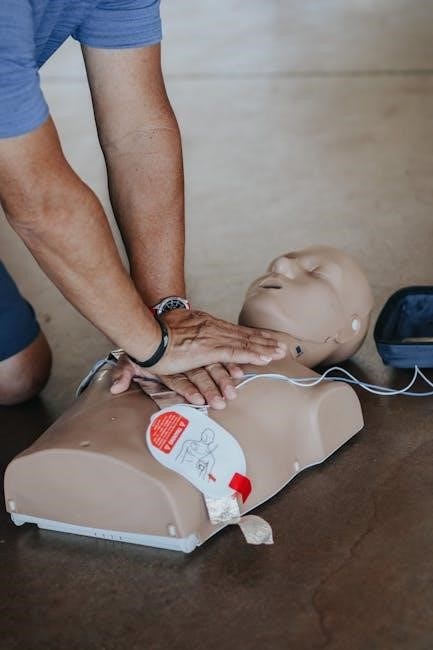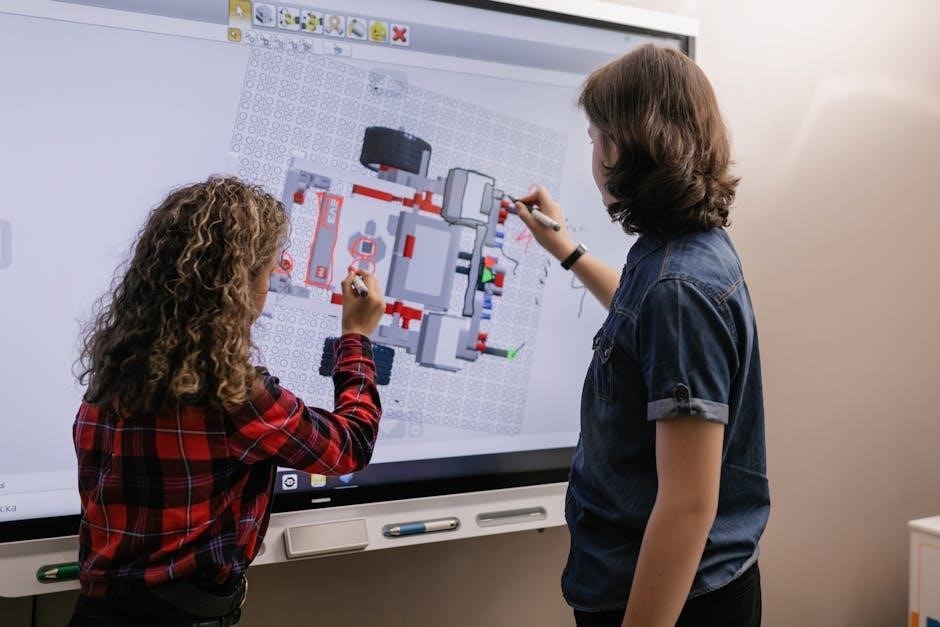
Instructional aides, also known as teacher assistants, play a vital role in supporting educators and students in educational settings. They assist with lesson preparation, student supervision, and academic support, ensuring a productive learning environment. Their contributions are essential for enhancing educational outcomes and alleviating teacher workloads, making them indispensable in modern classrooms.
Overview of Instructional Aides
Instructional aides are essential support staff in educational settings, assisting teachers and students to create an effective learning environment. They perform diverse tasks, including preparing materials, managing classroom activities, and providing individualized student support. These aides work in various settings, such as classrooms, libraries, and special education programs, adapting to the unique needs of each environment. Their role is flexible, often tailored to the specific requirements of the school or instructor they support, making them a vital component of the educational team.
Importance of Instructional Aides in Education
Instructional aides are crucial for fostering an effective and inclusive educational environment. By supporting teachers with lesson preparation and classroom management, they enable educators to focus on instruction. Aides also provide individualized attention to students, helping those with special needs or language barriers to thrive. Their presence enhances student engagement, academic outcomes, and overall classroom efficiency, making them a vital asset in promoting high-quality education and ensuring that all learners receive the support they need to succeed.
Definition and Roles of Instructional Aides
Instructional aides are essential support staff who assist teachers with lessons, manage classrooms, and provide direct student support, ensuring efficient educational operations.
What Are Instructional Aides?
Instructional aides, also known as teacher assistants or educational assistants, are support staff who work alongside teachers to facilitate student learning. They assist with lesson preparation, supervise students during activities, and provide individualized academic support. Instructional aides work in classrooms, libraries, or resource centers, often helping with tasks such as preparing educational materials, managing classroom supplies, and assisting with technology. Their roles are adaptable, depending on the needs of the teacher and students, making them invaluable in creating an effective learning environment.
Key Responsibilities of Instructional Aides
Instructional aides perform a variety of tasks to support teachers and students. Their responsibilities include preparing educational materials, managing classroom supplies, and assisting teachers with lesson delivery. They often work one-on-one or in small groups with students who need additional academic support. Aides also monitor student behavior, reinforce learning concepts, and assist with administrative tasks such as grading or organizing records. Their role is crucial in maintaining a structured and productive learning environment, enabling teachers to focus on instruction and student development.
Types of Instructional Aides
Instructional aides vary based on their roles and educational settings, providing tailored support to students and teachers in diverse classroom environments and specialized programs.
Teacher Aides
Teacher aides provide essential support to educators, assisting with lesson preparation, classroom management, and student supervision. They often work closely with students, offering individualized or small-group instruction. Additionally, they may handle administrative tasks such as grading papers or maintaining records. Their role is crucial in creating an organized and productive learning environment, allowing teachers to focus on instructional delivery. Teacher aides are adaptable, often supporting diverse student needs and contributing to the overall effectiveness of the classroom.
Special Education Aides
Special education aides work closely with students who have special needs, providing tailored support to ensure their educational and developmental goals are met. They assist with individualized education plans (IEPs), adapt instructional materials, and help students with daily living skills. These aides collaborate with special education teachers, therapists, and parents to create a personalized learning environment. Their role requires patience, understanding, and the ability to adapt to diverse student needs, ensuring each child receives the support necessary to thrive academically and socially.
Library and Media Aides
Library and media aides support the organization and operation of school libraries and media centers. They assist with cataloging books, maintaining resources, and helping students and staff locate materials. These aides also support media activities, such as setting up equipment for presentations or lessons. Their role ensures the library remains a functional and welcoming space, promoting learning and resource accessibility for the school community.

Qualifications and Training
Instructional aides typically require a high school diploma, with some roles demanding an associate’s degree or specialized training in areas like classroom management or special education support.
Necessary Qualifications for Instructional Aides
Instructional aides typically require a high school diploma or equivalent, with some positions preferring an associate’s degree or college coursework. Basic first aid and CPR certifications are often needed. Many employers also require training in classroom management, child development, or special education. Additionally, aides must pass background checks and demonstrate strong communication and interpersonal skills. Some roles may necessitate specialized certifications or bilingual proficiency, depending on the educational setting and student needs.
Professional Development Opportunities
Instructional aides can enhance their skills through workshops, training programs, and certifications. Many schools offer professional development courses on classroom management, child development, and special education strategies. Some aides pursue higher education, such as associate’s or bachelor’s degrees, to advance their careers. Certifications like the Certified Paraeducator program are also available, providing specialized knowledge. These opportunities not only improve job performance but also open pathways for career growth within the education sector.
Benefits of Instructional Aides
Instructional aides support teachers and students, enhancing educational experiences by assisting with tasks and providing individualized attention, improving learning outcomes and classroom efficiency significantly.
Support for Teachers
Instructional aides provide invaluable support to teachers by managing administrative tasks, preparing educational materials, and assisting with classroom organization. They help with grading, supervising students, and facilitating group activities, allowing teachers to focus on instructional delivery. By alleviating these responsibilities, instructional aides enable educators to concentrate on developing lesson plans and addressing individual student needs, ultimately enhancing the overall quality of education and reducing teacher workload. Their contributions create a more efficient and effective learning environment.
Enhanced Student Learning
Instructional aides significantly contribute to enhanced student learning by providing individualized attention and support. They assist students with complex concepts, facilitate small-group instruction, and help with hands-on activities, fostering a deeper understanding of material. By addressing diverse learning needs, aides enable students to progress at their own pace, boosting academic confidence and performance. Their involvement creates a more interactive and inclusive classroom environment, directly impacting students’ ability to achieve their educational goals and thrive academically.

Challenges Faced by Instructional Aides
Instructional aides face challenges such as limited training, varied responsibilities, and high student needs. They must balance support roles with initiative, often navigating role ambiguity.
Common Challenges
Instructional aides often encounter challenges such as limited training, high student-to-aide ratios, and diverse learner needs. Role ambiguity and lack of resources can hinder effectiveness. Managing classroom behavior while supporting individualized instruction demands patience and adaptability. Additionally, aides may face communication barriers with students or teachers, complicating collaboration. These challenges highlight the need for professional development and clear role definitions to ensure aides can effectively contribute to student success and teacher support.
Strategies to Overcome Challenges
To address challenges, instructional aides can benefit from professional development opportunities, such as training programs and workshops, to enhance their skills. Clear communication with teachers and students is essential, ensuring aligned expectations and collaborative efforts. Leveraging technology, like educational software, can streamline tasks and improve efficiency. Building strong relationships with students and educators fosters a supportive environment. Flexibility and adaptability are key, as aides often navigate diverse responsibilities and student needs, requiring creative problem-solving and patience.

Best Practices for Utilizing Instructional Aides
Effective communication and clear role definitions are key to maximizing the impact of instructional aides. Collaborate with teachers, ensure aligned goals, and leverage their skills strategically to support learning environments.
Effective Communication
Effective communication is crucial for instructional aides to collaborate successfully with teachers and students. By actively listening, clarifying expectations, and providing consistent feedback, instructional aides ensure seamless integration into the classroom. Regular meetings between teachers and aides help align goals and address student needs. Clear communication also fosters a positive environment, enabling instructional aides to adapt their support strategies effectively. This ensures that both educators and students benefit from their involvement, leading to improved academic outcomes and a more efficient learning process.
Clear Role Definition
Clear role definition is essential for instructional aides to function effectively within educational settings. Defined responsibilities ensure accountability and alignment with teachers’ goals. This clarity helps instructional aides understand their tasks, from supporting students to managing materials, fostering a collaborative environment. Clear roles also prevent confusion and ensure consistency in educational support. By establishing specific duties, schools can maximize the aides’ contributions, enhancing both teacher efficiency and student outcomes. Role clarity further promotes professionalism and enables aides to focus on their core mission of supporting education effectively.

Technology and Resources for Instructional Aides
Technology and resources empower instructional aides to enhance productivity and student engagement. Digital tools, educational software, and online platforms provide efficient support for lesson planning and delivery, fostering innovation in education.
Tools to Enhance Productivity
Digital tools like learning management systems (LMS), educational apps, and task management software help instructional aides streamline tasks. Google Classroom and Trello enable organized lesson planning and collaboration. Tools like Kahoot! and Quizlet support interactive learning, while time-tracking apps like Toggl boost efficiency. Access to online resources such as Khan Academy and PBS LearningMedia provides aides with supplemental materials. These technologies not only enhance productivity but also foster a more engaging and effective learning environment for students.
Online Resources for Professional Growth
Instructional aides can leverage online platforms like Coursera, edX, and the National Education Association (NEA) for professional development. Websites such as Edutopia and Understood.org offer practical strategies and tips to enhance teaching support. Additionally, YouTube channels focused on educational techniques provide visual learning opportunities. These resources enable aides to stay updated on best practices, explore new teaching methods, and expand their skill sets, ultimately improving their effectiveness in the classroom and fostering a more dynamic educational environment.